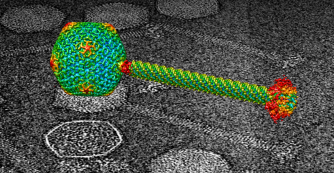Bacteriophages can be used to treat diseases caused by bacteria. “They were discovered before antibiotics, but their use has been abandoned due to the discovery of antibiotics. However the growing resistance of bacteria means that science is returning to bacteriophages,” Plevka says.
For the study he chose a bacteriophage attacking Staphylococcus Aurelius not only for the fact that resistance against antibiotics is very frequent with this bacteriophage but also due to the fact that this bacteriophage has a complex structure and so the process of infecting bacteria can be studied well on it.
The research team has already reached its first achievement in this direction. Structural biologists from Brno have published a description of how a bacteriophage penetrates a cell in PNAS, a journal published by the American National Academy of Sciences.
„In the article we describe structural changes of a bacteriophage which are vital for it to penetrate the cell. A phage is actually a molecular machine, in which many movements occur, which in the end enable it to deliver its genetic information into the bacterial cell,” Plevka says.
Like other viruses, it needs to get its own DNA into a bacterial cell in order to continue reproducing in it. So mainly it has to disturb the surface of the cell. “Our bacteriophage consists of a head and a flagellum. You can imagine the flagellum as two concentric tubes whilst the outer one has the ability to shorten itself. The phage attaches onto the cell wall with the tip of its flagellum, the outer tube shortens and the inner tube pricks into the cell like an injection needle,” the biologist describes the process of infection. However the phage still has to make sure that it really has penetrated through the cell wall, so other structural changes in the neck occur, where the flagellum connects to the head, which finally leads to the release of DNA.
It is not an easy thing to uncover the mechanism of the virus penetrating the bacteria. Scientists in CEITEC have the latest equipment for the study of the structure of living organisms at their disposal, however their microscopes are only capable of two-dimensional imaging. “In order to describe the structure of a bacteriophage and its changes, we had to make series of many thousands of pictures of phages in various stages of the time of penetrating the cell and then retrospectively calculate its three-dimensional structure in these various phases,” explains Plevka and adds that they needed hundreds of thousands of computational hours which they have thanks to the national supercomputing centre IT4Innovations.
The scientists have described the way of penetration of the bacteriophage into the Staphylococcus Aureus only on the phage itself so far. They made the phage make structural changes by means of osmotic shock, when they were changing the concentration of ions in the solution in which the bacteriophage was kept. Now they would like to continue in the study of the fact how the phage reacts with the cell directly and what further occurs in the cell.
Structural virologists in CEITEC MU are engaged in basic research and do not study the possible use of bacteriophages directly. However their work may help other scientists in the studies of whether and how it would be possible to use them in the fight against bacterial infections.

Change institution
- About Institution
- Research
-
Core Facilities
- CEITEC Nano Research Infrastructure
- Biomolecular Interactions and Crystallization
- X-ray Diffraction and Bio-SAXS Core Facility
- Nanobiotechnology Core Facility
- Josef Dadok National NMR Centre
- Cryo-electron Microscopy and Tomography
- Proteomics Core Facility
- Plant Sciences Core Facility
- Cellular Imaging Core Facility
- Genomics Core Facility
- Multimodal and Functional Imaging Laboratory
- Collaboration
- News/Events
- Contacts







